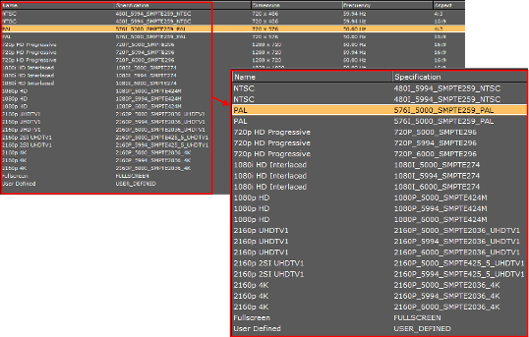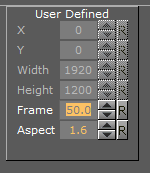
Viz Engine
Version 3.9.1 | Published February 12, 2018 ©
Output Format
You can set the output format of the rendering engine on this section. All video hardware configurations are hooked to the video standard set as output format. This setting defines the frequency (frame rate) at which Viz Engine is running.

For PAL and NTSC, you can set the aspect ratio to 4:3 (standard TV) and 16:9 (wide screen TV). Fullscreen sets the output format to the screen size on the current machine. Fullscreen also allows the modification of the frame rate setting, but not other settings.
Viz Engine supports UHDTV and 4K (see UHDTV and 4K Support). UHDTV and 4K formats are only displayed when the system hardware supports it.
Click User Defined to open a panel below the output format list. You can use user defined output format to fit the requirements of multi-pipe systems, such as a video wall. Configure the multi-pipe settings in the right part of the editor.

Setup of multi-pipe systems should be performed by experienced system engineers. For more information, contact your local Vizrt representative.
-
X: Sets the horizontal alignment in pixels on the screen. Value is calculated from top left of the screen.
-
Y: Sets the vertical alignment in pixels on the screen. Value is calculated from top left of the screen.
-
Width: Sets the width in pixels.
-
Height: Sets the height in pixels.
-
Frame: Sets the refresh rate/frequency per frame in hertz (Hz).
-
Aspect: Sets the aspect ratio. For example 1.778:1 which is 16:9 or 1.333:1 which is 4:3. The designer can set other aspects ratio for each individual scene, as described in the Scene Settings section of the Viz Artist User Guide.
Note: Make sure that the physical refresh rate of the graphics hardware and the video hardware is configured correspondingly.
There are 3 frequency groups/families; 50, 59,94 and 60 Hz. This defines the output format, and how fast Viz Engine operates. The frequency is the same as frames per second. This will also define the input format that is allowed; hence, an NTSC SD input cannot produce a PAL SD output, but an HD input with the same frequency as the SD output would work.
UHDTV and 4K Support
-
UHDTV and 4K resolution is currently supported on Matrox X.mio3 and Matrox DSX LE Series 3/4KO.
-
For most use-cases, Matrox X.mio3 is the preferred video board.
-
For UHDTV and 4K output, carefully observe these requirements:
-
UHDTV (3840x2160) is supported on DSX.LE3/4KO and X.mio3.
-
4K (4096x2160) is supported on DSX.LE3/4KO only (DSX.LE3/4KO does not support any other resolutions).
-
3G Level B for UHDTV is supported on DSX.LE3/4KO and X.mio3. 3G Level B for 4K is supported on DSX.LE3/4KO only.
-
To output fill and key in UHDTV and 4K on a DSX.LE3/4KO two video boards are required. One board will provide fill, the other board provides the key. X.mio3 with at least 8 outputs will support fill and key.
-
UHDTV and 4K setups always need correct genlocking. When two DSX.LE3/4KO video boards are used both boards need to be gen-locked to the same sync source.
-
Inputs are not supported in UHDTV and 4K.
-